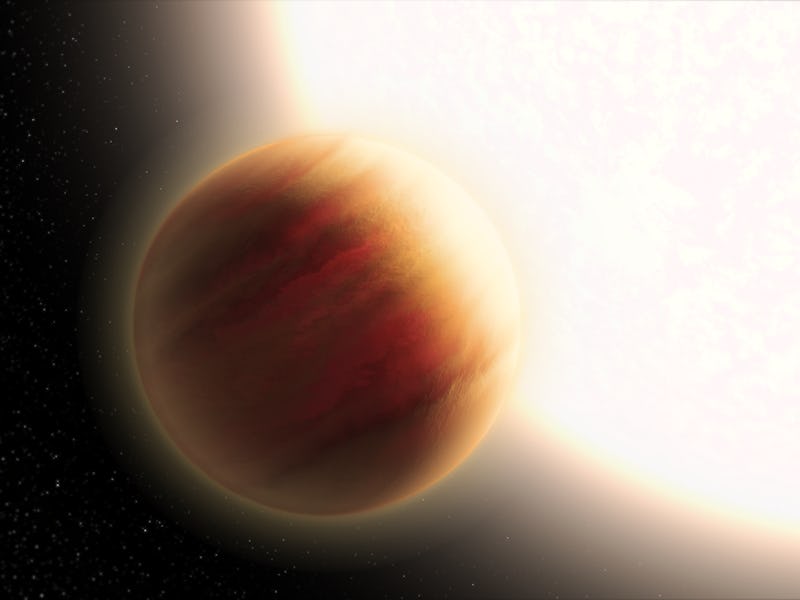Scientist are dumbfounded by the bizarre atmosphere color of this hot planet
WASP-79b is a strange world.

Amidst the hunt for exoplanets, astronomers are ultimately searching for signs of habitability and a world similar to our own. However, along the way, they often encounter strange, new worlds that defy the laws of astronomy as they know it.
WASP-79b happens to be one of those worlds. The gaseous giant exoplanet has scorching temperatures, iron rain and yellow skies.
In a study, published this week in The Astronomical Journal, a team of researchers analyzed the atmosphere of WASP-79b and found no evidence for Rayleigh scattering, the atmospheric phenomenon that turns the sky into its familiar blue color. Instead, the study suggests that the exoplanet has a yellowish sky.
"I've shown the WASP-79b spectrum to a number of colleagues, and their consensus is 'that's weird,'" Kristin Showalter Sotzen, a researcher at the Johns Hopkins University Applied Physics Laboratory in Laurel, Maryland, and lead author of the study, said in a statement. "This is a strong indication of an unknown atmospheric process that we're just not accounting for in our physical models."
In the quest to find an Earth-like planet, we've found some doozies.
What makes a sky blue? Sunlight scatters off of the molecules found in the atmosphere. This scattering process, also known as Rayleigh scattering, happens to be more effective at shorter wavelengths, which is the blue end of the visible spectrum, or the portion of electromagnetic radiation that can be seen by the human eye.
Therefore, the light that is scattered down to Earth is predominantly blue, resulting in our blue daytime skies.
Strangely enough, this process does not take place in WASP-79b, and may be indicative of an unknown atmospheric phenomenon that astronomers are not yet familiar with.
However, they believe it may have to do with the evolution of the exoplanet's atmosphere.
WASP-79b is a 'hot Jupiter' planet, and it measures at around 1.7 times the radius of Jupiter. In fact, the exoplanet is one the largest exoplanets scientists have observed thus far. It orbits a large, hot star at a short distance.
The planet's host star is 1.64 times the radius of the Sun, and is much brighter than Earth's host star, according to NASA. WASP-79b orbits its star at 0.0519 astronomical units, a unit of length that is approximately the distance between the Earth and the Sun. As a result, the exoplanet only takes close to four days to complete a full orbit around its star.
Temperatures on WASP-79b can reach up to 3,000 degrees Fahrenheit. That's the same temperature as molten glass. In fact, the planet is so hot and humid that instead of water, it may rain molten iron on WASP-79b.
To take a closer peek at this strange world, the team of scientists behind the new study used the Magellan II Telescope at Las Campanas Observatory in Chile to analyze the wavelengths of light in the planet's atmosphere.
Through their observations, they found that the shorter, bluer wavelengths of light appear to be more transparent, indicating less absorption and scattering by the atmosphere, according to the researchers.
"Because this is the first time we've see this, we're really not sure what the cause is," Sotzen said. "We need to keep an eye out for other planets like this because it could be indicative of unknown atmospheric processes that we don't currently understand."
Further observation of WASP-79b could provide a better insight into the turbulent worlds of hot Jupiters. However, because this is the only example of a planet where there has been no evidence of Rayleigh scattering, it is unclear whether it is linked to the evolution of the atmosphere of WASP-79b.
Abstract: As part of the Panchromatic Exoplanet Treasury program, we have conducted a spectroscopic study of WASP-79b, an inflated hot Jupiter orbiting an F-type star in Eridanus with a period of 3.66 days. Building on the original WASP and TRAPPIST photometry of Smalley et al., we examine Hubble Space Telescope (HST)/Wide Field Camera 3 (WFC3) (1.125–1.650 μm), Magellan/Low Dispersion Survey Spectrograph (LDSS)-3C (0.6–1 μm) data, and Spitzer data (3.6 and 4.5 μm). Using data from all three instruments, we constrain the water abundance to be −2.20 ≤ log(H2O) ≤ −1.55. We present these results along with the results of an atmospheric retrieval analysis, which favor inclusion of FeH and H− in the atmospheric model. We also provide an updated ephemeris based on the Smalley, HST/WFC3, LDSS-3C, Spitzer, and Transiting Exoplanet Survey Satellite (TESS) transit times. With the detectable water feature and its occupation of the clear/cloudy transition region of the temperature/gravity phase space, WASP-79b is a target of interest for the approved James Webb Space Telescope (JWST) Director's Discretionary Early Release Science (ERS) program, with ERS observations planned to be the first to execute in Cycle 1. Transiting exoplanets have been approved for 78.1 hr of data collection, and with the delay in the JWST launch, WASP-79b is now a target for the Panchromatic Transmission program. This program will observe WASP-79b for 42 hr in four different instrument modes, providing substantially more data by which to investigate this hot Jupiter.